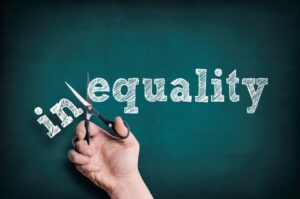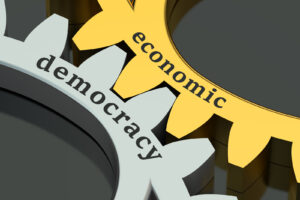This site promotes Cooperative Social Entrepreneurship as defined in About and framed by the themes introduced below. Scroll down for theme summaries and to internal links for more coverage.
Values & Vision
You don’t put the cart before the horse. You have to start with WHY: Identify those values you will use as compass to seek change, here health, environment, equity and democracy. This moral compass gives a vision, not for an imprecise concept of sustainability, but for operationalisation through Result-focused Stewardship, defined as:
A healthy, fair and environmentally sound economy where cities and communities take responsibility for own supply chains, for reduced inequality and for economic democracy.
 |
 |
(Right image): Inspired by Doughnut Economics , CC BY-SA 4.0 (click here for larger image) and (left image): Inspired by T. Piketty. Photo Credit: Istockphoto.
Values embodied by Principles

Photo credit Can Stock Photo
“Society long ago democratized government, but we have never democratized the economy.”
Marjorie Kelly and Ted Howard (2019): The Making of a Democratic Economy. Building Prosperity for the Many, Not Just the Few.
See Economic Democracy defined through 8 principles
Part-Goals
(Re) Location of the Economy
|
A Real Circular Economy
For a larger image, click UB |
| Globalization has resulted in wealth being extracted from local communities. To regain control and economic democracy, we need a (Re) Location of the Economy.
|
The circular economy will only be a reality if it is incorporated in business models. Osterwalder and Pigneur’s model (‘the Business Model Canvas’) belongs to the linear economy. It is not suitable for a circular economy based on ‘cradle-to-cradle thinking’, regenerative agriculture and an ‘Stahel-style’ industrial circular economy. Jonker and Faber’s (2021) model, on the other hand, facilitates circular, collective business models – for Cooperative Social Entrepreneurship. |

The Community Wealth Building Model (CWB)
The CWB model (2 min. video) serves as a Solution Multiplier and operational vehicle for Equality, Economic Democracy and Climate, using the means of Economy (Re) Location and a Real Circular Economy. This is System Change, but starting at the Local Level, tested out in UK & USA.
Short on Values & Vision:
Doughnut Economics graphic:
“The model resembles a doughnut where the doughnut ring itself represents a safe and just space for humans to exist within. Inside the ring (the doughnut hole) represents a situation in which people lack essential social necessities such as healthcare, education and political voice. Meanwhile, the outside of the doughnut (the crust) represents ecological boundaries beyond which earth’s natural systems are under threat.
… prosperity can be achieved when we are situated in the middle ring, neither overshooting planetary boundaries nor lacking the necessary social foundations for all people. As Kate Raworth, founder of Doughnut Economics, has said, ‘A healthy economy should be designed to thrive, not grow’. “
Kori Goldberg (February 10, 2023) Back to basics: A systems thinker’s view on circularity
Reduced Inequality
This is necessary simply for the majority to live ‘within the middle ring of the doughnut’, defined above as constituting the necessary social foundations for all people.
Reduced inequality is an important value also for democratic reasons. As argued by the US Supreme Court Justice Louis Brandeis during the great depression:
«We can either have democracy in this country or we can have great wealth concentrated in the hands of a few, but we can’t have both.»
Further references:
- A systems approach [§ D.1: Spreading economic power is necessary to reduce Inequality: Some strategies based on Piketty’s research]
- Why going Local? [See the subtitles: Reducing Inequality: Why local ownership of businesses is important and Inequality and Democracy are closely Related]
- Principles [§ 4: Putting Labor before Capital]
- Community Wealth Building: A road to Economic Democracy. [See subtitle: Redistribution of the sources of Value Creation]
Short on Principles
Why do we need a democratic economy?
As far back as 1848, John Stuart Mill considered a more democratic economy a condition for a robust democratic society. More recently, Guinan and O’Neill have argued that:
«If we want to live in democratic societies, then we need to have democratic institutions that allow communities to shape their local economies, and to exert real control over the way in which those local economies develop over time. Treating the economy as some kind of separate technocratic domain in which the central values of a democratic society somehow do not apply is no longer good enough.
On the contrary, taking democracy seriously involves being prepared to extend it deep into economic life – including into the ownership of enterprise.»
Joe Guinan and Martin O’Neill (2020:47): The Case for Community Wealth Building
Related to this, is our schizofrenic approach to personal and business- moral, succinctly illustrated by Joel Bakan:
«Few businesspeople would dispute that their decisions must be designed primarily to serve their company’s and its owners’ interests. As former Goodyear Tire CEO Sam Gibara said, “If you really did what you wanted to do that suits your personal thoughts and your personal priorities, you’d act differently. But as a CEO you cannot do that.»
Bakan, Joel. (2004:51): The Corporation: The pathological pursuit of profit and power
8 principles for a Democratic Economy
(1) The common good comes first. (2) Inclusion: «The prosperity of ordinary people is the sun around which a democratic economy orbits. That points to a principle of inclusion for those long excluded.» (Kelly and Howard, ibid). (3) Building community wealth that stays local. Keeping this wealth local means using locally rooted ownership, ideally held broadly. (4) Putting labor before capital; Good work at living wage & undoing the bias towards capital. (5) Democratized Ownership designs (6) Ecological sustainability. (7) Ethical Finance for Social and Ecological benefit. (8) System-change as the ultimate goal.
Adapted from: Kelly og Howard, ibid. with addition- for the 8. principle: Joe Guinan og Martin O’Neill (2020): The Case for Community Wealth Building)
Further references:
- A systems approach [§ D.3: It is only with Economic Democracy, we get Real Democracy and G: Tools for System Change; ownership design, democratization of: capital, decision-making and production].
- Why going Local? [See the subtitle: The Democratic Argument for Localization]
- Principles [§ 5: Creating Enterprise Designs for New Era: The Principle of Democratized Ownership]
- Community Wealth Building: A road to Economic Democracy
Short on Goals
(Re) Location of the Economy
Instead of globalization’s ‘trickle down benefits’, wealth has been extracted from local communities, making them loose control over own development. To regain this control, we need a (re) location of the economy. This also follow naturally from the economic democracy-agenda.
- Principally, localization mean the process of organising business, industry and processes, so that its main activities happen in local areas (at community or regional level) rather than nationally or internationally.
- It can be seen as a principle of global responsibility, but acted upon at the city scale, as per the economist Kate Raworth’s argument that cities must take on global responsibility for their [own] supply chains. Dependence on global supply chains has also made us vulnerable to international crises and reduced our ability to manage our own economy, including the prices of basic goods such as electricity and food.
«..This sustainability challenge will be won or lost in cities, which are now the most common human habitat, primary economic drivers, and the most powerful physical and political leverage points for change. Cities occupy only 2 per cent of the world’s land surface, but use some 75 per cent of the world’s resources, and release a similar percentage of wastes.» [www.gdrc.org/uem/footprints/girardet.html]
[Ede 2016: The Real Circular Economy]
- Local circular economy solutions are decisive:
«The circular economy approach can reduce demand for energy and materials and production of waste, but if a city is not making things locally, does it truly have a circular economy? ..A true circular economy means relocalising production in our cities, needing to move less stuff, and making more of what we need, when and where we need it.»
[Ede;ibid.]
The farther materials need to travel, more energy is needed and it’s less likely relatively small amounts of materials will be shared between businesses or processes. Local circular systems (..) facilitates small business to business waste synergies.. [Jonathan Pereira (21. Nov. 2018) What is a local circular economy?]
Further references:
- A Systems Approach [Part II: On Relocation of the Economy]
- Principles [§ 3: Building Community Wealth that stays Local; The Principle of Place and § 7: Investing and Lending for People and Place]
Circular business models aligned with a real a Real Circular Industrial Economy ‘Stahel style’
In Walter Stahel’s ‘Performance economy’, the actors retain ownership and responsibility for the goods AND the materials they contain. Ideally, the performance economy starts with the design of the products and not, as with the ‘conventional circular economy’, with the sale of finished goods. In summary:
- The actors of the performance economy sell performance (results, maximum use) instead of goods.
- The actors retain ownership of the goods and the materials they contain.
- Ideally, the circuit for physical goods is connected with molecular circuits to recover pure atoms and molecules when manufactured products or components cannot be reused (e.g. alloys/material mixtures that must be separated).
- The costs of product liability, risks and waste are internalized thus providing a strong financial incentive to prevent loss and waste.
- The goods are sold as a service for the longest possible time. Profit is maximized by utilizing smart solutions from material- and life sciences, sufficiency strategies and system solutions.
- Extended Performance Liability -EPL (Stahel 2019). This ensures a long-term perspective. Note that the EPL is far more comprehensive than the EU legislation for Extended Producer Responsibility (EPR), which allows the outsourcing of responsibility to third parties.
See Walter R. Stahel (2010) The Performance Economy. 2nd Edition and Walter R. Stahel 2019: Circular Economy-A users guide)
The performance economy addresses the problem of separation of power and responsibility:
«..the separation of power and responsibility is the fundamental problem of our current economic system.. Our current production chain is organized so that nobody ever really needs to take responsibility for the consequences of their actions.. The power to influence the production process and the responsibility for the consequences are separated from each other by the distance of an entire ‘production chain’; meet the linear economy.»
(Rau og Oberhuber 2023:179, 40: Material Matters. Developing for a Circular Economy) [R&O])
To remedy this fundamental problem, R&O argues that:
- Those who determine production processes must have a duty to manage their long-term consequences, and not be able to sell and resell their responsibility through the production chain
- Manufacturers must hold on to their products and sell them as a service instead
- Materials (input materials and raw materials – right down to the molecular level) must also be sold as a service
Inventories, infrastructure and products must be designed and considered as resource banks. E.g. buildings will be equipped with a material passport to ensure continued use for future generations:
“..buildings should be seen as material banks, temporarily storing materials and conserving their value until they can be dismantled and reused elsewhere. Materials passports and registries* can then be used to keep track of their identity and location so that they can eventually be recovered and continue to circulate within the economy.”
(ibid.: Foreword by Dame Ellen MacArthur)
* For Norway, see Materialbanken Madaster-Circular Norway
Important references are also Braungart and McDonough’s model for biological and technical cycles as well as the latter’s concept of the ‘carbon economy’ (see forthcoming page for how this in turn relates to Barry Commoner’s ‘four laws of ecology’).
‘But the circular economy can only be a reality for businesses if there are viable business models. Business models constitute the basic component of enterprises, being at the heart of value creation’ (Jonker et.al. 2018) [1]. Jonker and Faber followed up in 2021 with a comprehensive guide for the design and implementation of new circular business models.[2] Together with Haaker, they authored yet another paper in 2022, now as a whitepaper commissioned by the Dutch Ministry of Economic Affairs and Climate Policy. [3]
[1] Jonker, J., Kothman, I., Faber, N. and Montenegro Navarro, N. (2018). Organising for the Circular Economy. A workbook for developing Circular Business Models. Doetinchem: OCF 2.0 Foundation.
[2] Jan Jonker , Niels Faber (2021): Organizing for Sustainability. A Guide to Developing New Business Models
[3] Jan Jonker, Niels Faber and Timber Haaker (2022) Quick Scan Circular Business Models Inspiration for organising value retention in loops. Whitepaper, Ministry of Economic Affairs and Climate Policy, The Netherlands.
Community Wealth Building (CWB):
- Economic System-Change, but Starting at The Local Level
- Where Municipalities can Make a Difference
Economic Democracy and a Real Circular Economy ‘Stahel-style’ can be operationalized through ‘Community Wealth Building’ – a model tried out successfully in the USA and UK during during the last decade. It implies a (re-) localization of the economy where municipalities actively promote the circular economy, and whith coops playing important roles.
Preston, UK, once described as ‘England’s suicide capital’, was named by PwC as ‘the most improved city in the UK’ in 2018.
The 5 pillars of the CWB model:
- Widely spread ownership of property and assets. Development of locally rooted companies with democratic ownership. Cooperatives, worker, public, and non-profit ownership make it more likely that values will remain (not leak out to distant shareholders and headquarters).
- Locally rooted finance. Cities and local institutions should redirect money in service of the real economy through public and community banks, credit unions, targeted public pension investments.
- Fair work. Every worker must receive a living wage and real power in and control of their workplace for decent work and conditions, and advancing trade union rights.
- Just use of land and property. Cities should mobilize land and property assets to build real wealth in communities, bring local land and real estate development back under community control, and combat speculation and displacement.
- Progressive procurement. Local governments and place-based “anchor institutions” [see CWB business model below] should lead with procurement practices that re-localize economic activity, build local multipliers and end leakage and financial extraction.
(Last 4 paragraphs quoted from the American thinktank DemocracyCollaborative)
‘Anchor institutions’ plays a significant role in CWB’s business model. As explained in the original model of community wealth building, -in Cleveland, Ohio, USA:
“Cleveland’s community wealth building’ project emphasises the role large institutions rooted in a municipality such as hospitals, airports, colleges, housing associations – and local authorities themselves – can play as ‘anchors’ around which regional economic ecosystems can stabilise and grow.
By allocating more of their spend budgets to local suppliers and producers, recruiting from the workforce on their doorsteps and incubating local businesses and community organisations, the anchors can keep wealth flowing in municipal economies.”
Justin Reynolds (Aug. 2017): Could Preston provide a new economic model for Britain’s cities?
The EU procurement directive from 2014, which allowed greater emphasis on social and environmental criteria, has enabled progressive procurement processes, which the city of Manchester in England says has resulted in savings of 85 million dollars over a ten-year period (Global network for public servants-Apolitical). When aligned with CWB, such procurement make it easier to promote the transition to a real circular economy.
Redistribution of the sources of Value Creation
CWB complements conventional redistribution. What CWB adds is redistribution of the very sources of value creation. In other words, a (re-) localization of the economy that also becomes a democratic and more egalitarian economy:
«Community Wealth Building supports democratic collective ownership of the local economy through a range of institutions and policies.. [including] worker cooperatives, community land trusts, community development financial institutions, so-called ‘anchor institution’ procurement strategies, municipal and local public enterprises, and public and community banking.
[It] shift the position of individual citizens from being bystanders, who can only watch economic forces play out in their local communities, to active participants, who can collectively give some form and direction to the economic future of their local area.»
Joe Guinan and Martin O’Neill (2020:2, 47-48): The Case for Community Wealth Building
Further references:
- A Systems Approach [See More on Tools, Business Models and Entrepreneurship for Relocation of the Economy, §1: Experience from a decade of Community Wealth Building as a political and economic strategy.
- Principles: See all the Principles for the significant overlap with the Principles of Community Wealth Building, i.e. the 5 pillars of the CWB-model.

